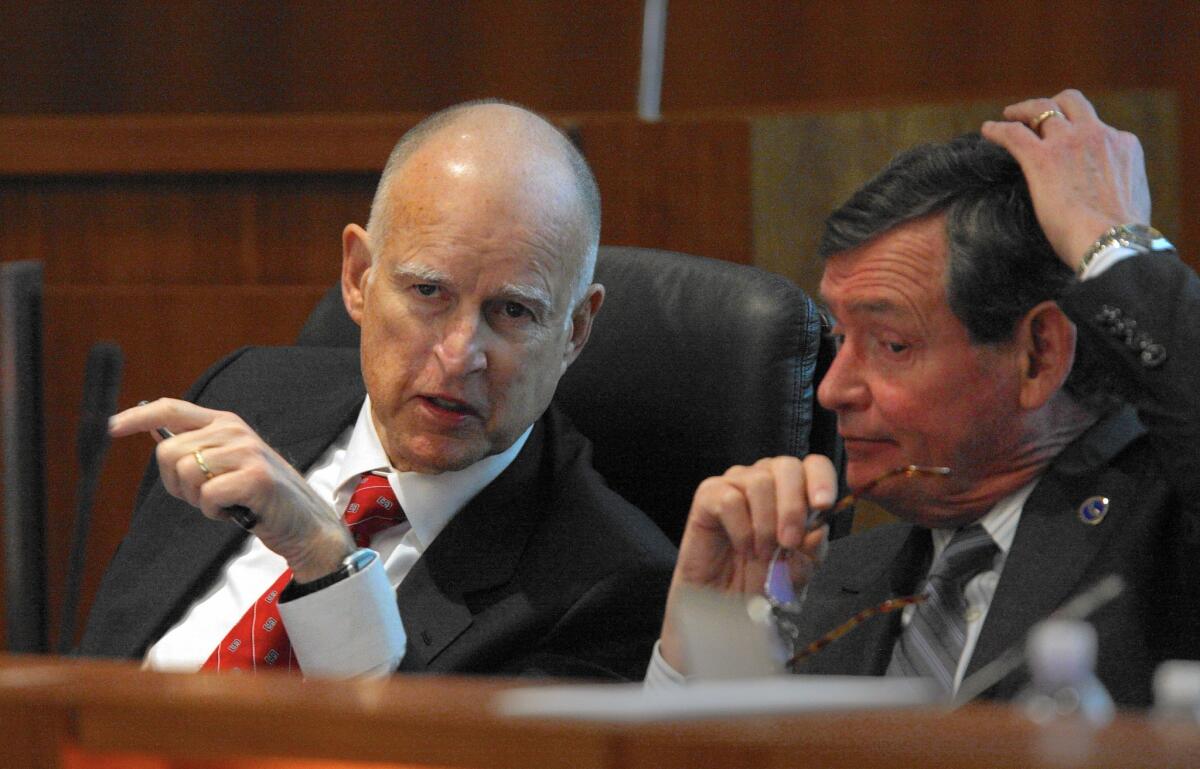For higher education funding, softer touch gave Cal State a leg up

- Share via
California State University officials had one question in mind 18 months ago: In a state with billions of dollars in spending obligations to health and welfare services, prisons and pensions, how do we catapult our funding needs to the top tier of budget priorities?
The answer involved a carefully plotted campaign that involved engaging key legislators, an aggressive social media push and socks — yes, red socks, saying #StandWithCSU, that were a bipartisan hit with Sacramento lawmakers. Those efforts, and others, helped the 23-campus system win an additional $97 million in state funding for 2015-16.
It also didn’t hurt that Cal State is the largest higher-education system in the nation, with a vast network of more than 3 million living alumni, 460,000 students and 47,000 faculty and staff to help press its cause. And the university’s appeal probably met willing listeners in the 39 members of the Legislature who are Cal State alums.
The system contributes significantly to the state’s workforce, annually awarding more than half of California’s bachelor’s degrees and more degrees in nursing, teaching, engineering, agriculture and business than any other higher-education institution in the state.
Cal State’s leaders crafted those facts into a narrative that became the theme of the #StandWithCSU strategy. The campaign, for example, relied on faculty and students from campuses with agricultural programs, as well as the industry, to lobby for increased funding from agriculture committee members. This targeted approach was also employed in other areas such as healthcare.
“We tried to build a more assertive, direct advocacy component and focused on, how do we use third parties to tell our story? How do we use social media, our alumni and supporters at the local level to engage people? What do we do in the long term to educate lawmakers about CSU’s value?” said Karen Zamarripa, Cal State’s assistant vice chancellor for advocacy and state relations, who coordinated efforts. “We tried to pinpoint what was going to make us a priority. Last year, we had two recommendations in the Assembly to augment our budget, but we fell off the list.”
Cal State’s goal was to emphasize the positive.
“My sense is that the CSU is striking the right tone with lawmakers — underscoring that the trustees’ budget request is in the best interest of California’s society and economy,” Chancellor Timothy P. White told trustees in March. “This is a positive case for reinvestment, based on optimism for the future.”
White also indicated early on that the system would not seek to raise tuition or use the threat of a tuition hike as a bargaining chip — unlike University of California President Janet Napolitano, who, before the budget deal was struck, had indicated UC would need to increase tuition by as much as 5% each year for the next five years.
White’s “soft-spoken but determined and collaborative” approach was welcomed by many legislators, said Assemblywoman Kristin Olsen (R-Modesto).
“From day 1 he has engaged in explaining CSU needs in ways that resonated with individual legislators, rather than bullying,” Olsen said.
Some in the Cal State system privately grumbled that Napolitano’s efforts were forceful and that Cal State was taking a less aggressive stance that might not be successful.
Many, including those inside and outside the Legislature, credited Napolitano with raising the profile — and the stakes — of the funding debate.
But Olsen said the tuition threats didn’t play well with many legislators. Or Gov. Jerry Brown.
“It’s pretty clear that UC’s more confrontational approach didn’t work especially well with this governor,” said Steve D. Boilard, executive director of the Center for California Studies at Cal State Sacramento. “Both UC and CSU managed to get considerably more funding than the governor was originally offering, but UC’s additional funding is largely one-time and restricted to specific purposes, while CSU’s additional funding is largely ongoing and nonrestricted.”
Brown addressed the two systems’ different tactics at a news conference in June, when the budget deal was announced. He was asked whether he felt that Cal State had behaved well and UC had not.
“Well, I wouldn’t put this in terms of my feelings, or even feelings in general,” he said. “This is a process that incorporates thinking from the Assembly, thinking from the Senate and thinking from the executive branch.
“And we meld that all together and we come up with this agreement and it just so turned out that this is the budget we had. So it’s true, CSU did a little better than UC,” the governor said. “But the UC is getting some special money if they can enroll 5,000 [California] students, as they should.”
Funding changes in the state’s Middle Class Scholarship program, which totaled more than $100 million, helped Cal State, officials said.
“It was absolutely critical that the Assembly speaker [Toni Atkins] and I collaborate together with the focus of doing everything in our power to make sure we could provide more accessibility for working-class kids in California — whether it was general funds or whatever revenues we could find,” said Senate Pro Tem Kevin de León (D-Los Angeles).
State support for higher education has been declining for decades, but plunged dramatically during the recession, with Cal State, UC and community colleges losing billions of dollars. Funding has increased incrementally under Brown but not to pre-recession levels. Brown has repeatedly cautioned that higher-education leaders must face new fiscal realities of leaner budgets and greater accountability for student success.
Brown had been unwilling to provide additional state funding to either UC or Cal State beyond the $119.5 million proposed in his 2015-16 budget. Cal State requested $216.6 million — $97 million more than Brown’s proposal — part of which would be used to enroll an additional 12,000 students.
During final budget negotiations, 83 lawmakers signed a letter requesting that Atkins and De León support at least $90 million in additional funding for Cal State.
They were rewarded with #StandWithCSU door signs, and pictures of those signs soon flooded Twitter, Facebook, Instagram and other social media. Scores of legislators wearing #StandWithCSU socks again lit up social platforms.
Cal State faculty groups reached out to the powerful California Teachers Assn. to argue the importance of providing increased funding to enroll more freshmen at Cal State campuses.
“We had labor groups solidly behind us and local campuses and K-12 did a nice job of presenting a good picture of: ‘Here is what CSU can do,’” said Cal State Stanislaus professor Steve Filling, who is chairman of the Academic Senate.
Campus-based stories about the numbers of qualified students denied admission had a powerful impact on legislators, said Cal State Fresno President Joseph Castro.
A delegation of faculty and students from the Fresno campus could sense a turning point during a spring meeting with 15 lawmakers at the Capitol.
“We were hearing clear language indicating strong support of our budget, and especially for that $97 million, from every single legislator,” Castro said.
Sacramento, analysts and others say, tends to bend to the most powerful constituencies.
Unlike K-12 schools and community colleges, which are guaranteed funding under Proposition 98, Cal State and UC largely depend on tuition and general fund dollars — subjecting them to the whims of politicians juggling competing interests.
Future funding success for Cal State and UC is not a given, they say.
“I do not think that this year’s augmentations reflect a fundamental change in thinking about how to fund higher education,” Boilard said. “Rather, I think it’s a reflection of the well-established pattern where higher education gets cut more than most other programs during tough financial times, and rebounds more than most other programs during better financial times.”
[email protected]
Twitter: @carlariveralat
More to Read
Sign up for Essential California
The most important California stories and recommendations in your inbox every morning.
You may occasionally receive promotional content from the Los Angeles Times.











